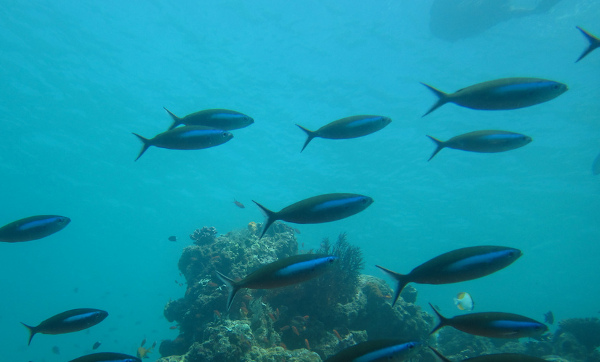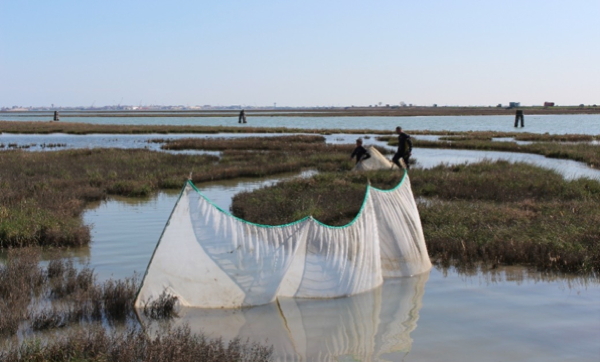Animal Ecology

Research is carried out within the laboratory aimed at studying the ecology of aquatic organisms, with particular attention to the nectonic component. The main research activities are:
- Analysis of samples of nectonic, planktonic and benthic fauna;
- Biometric and somatic condition analyzes;
- Analysis of abiotic environmental variables;
- Analysis of stomach contents of fish.
The research is aimed at studying the ecology of freshwater, brackish and marine coastal nectonic species; the assessment of the ecological status of transitional aquatic environments; the ecological restoration of transitional aquatic environments as a habitat for nectonic fauna; the conservation of habitats and biodiversity in transitional aquatic and marine-coastal ecosystems.
Collaborations
- Dipartimento di Scienze della Terra e del Mare dell’Università degli studi di Palermo
- WWF Oasi – Valle Averto (Dr. Stefano Borella)
- Corila, Consorzio per il coordinamento delle ricerche inerenti il sistema lagunare di Venezia
- Ente Parco Naturale Regionale Veneto Delta del Po
Publications
- Andolina C.; Franzoi P.; Cavraro F.; Jackson A.L.; Mazzola A.; Vizzini S., 2022. Trophic adaptability shapes isotopic niche of the resident fish Aphanius fasciatus across lagoon habitats in ESTUARINE, COASTAL AND SHELF SCIENCE, vol. 264, pp. 1-11
- Scapin, Luca; Zucchetta, Matteo; Pranovi, Fabio; Franzoi, Piero, 2021. Influence of Seascape on Coastal Lagoon Fisheries: the Role of Habitat Mosaic in the Venice Lagoon in ESTUARIES AND COASTS, vol. SN (ISSN 1559-2723)
- Zucchetta M.; Scapin L.; Franco A.; Franzoi P., 2020. Uncertainty in developing fish based multi-metric indices in ECOLOGICAL INDICATORS, vol. 108, pp. 105768 (ISSN 1470-160X)
- Cavraro, Francesco; Bettoso, Nicola; Zucchetta, Matteo; D’Aietti, Alessandro; Faresi, Lisa; Franzoi, Piero, 2019. Body condition in fish as a tool to detect the effects of anthropogenic pressures in transitional waters in AQUATIC ECOLOGY, vol. 53, pp. 21-35 (ISSN 1386-2588)
- Scapin, Luca; Zucchetta, Matteo; Sfriso, Adriano; Franzoi, Piero, 2019. Predicting the response of nekton assemblages to seagrass transplantations in the Venice lagoon: An approach to assess ecological restoration in AQUATIC CONSERVATION-MARINE AND FRESHWATER ECOSYSTEMS, vol. 29, pp. 849-864 (ISSN 1052-7613)
- Scapin, L., Zucchetta, M., Sfriso, A., Franzoi, P., 2018. Local habitat and seascape structure influence seagrass fish assemblages in the Venice lagoon: the value of conservation at multiple spatial scales. in ESTUARIES AND COASTS, vol. 41, pp. 2410-2425 (ISSN 1559-2731)
Equipment

- Optical microscopes and stereo microscopes
- Portable instrumentation for environmental analyzes
Research projects

Coastal lagoon habitat (1150*) and species recovery by restoring the salt gradient increasing the fresh water input
The LIFE16 NAT / IT / 000663 -REFRESH- "Coastal lagoon habitat (1150 *) and species recovery by restoring the salt gradient increasing fresh water input" project involves 5 partners with the aim of recreating the typical oligo-mesoaline conditions of estuarine environments. Up to 1000 l/s of water derived from the Sile river will be introduced into the lagoon to form a few hectares of Phragmites australis reed beds with the function of phytoremediation, counteracting the effects of the overflow of the river in particularly rainy periods, reducing eutrophication and increasing the biodiversity of these environments now almost completely disappeared in a heavily marinated lagoon. The transplantation of reeds and aquatic seagrasses is complementary to the actions of the LIFE12 NAT/IT/000331-SERESTO project to re-naturalize the northernmost area of the northern lagoon.
Website: http://www.lifelagoonrefresh.eu/

Evaluation and improvement of the environmental sustainability of artisanal fishing in the Natura 2000 sites of the Venice lagoon
Reg. (UE) n. 508 del 15 maggio 2014 - Fondo Europeo per gli Affari Marittimi e la Pesca (FEAMP)
The project aimed to promote the environmental sustainability of artisanal fishing and to protect biodiversity in the Venice lagoon. Overall, the project highlighted the potential of traditional fishing in the Venice lagoon, not only as an activity of sustainable exploitation of the lagoon's biological resources, but also as an activity that can effectively contribute to environmental management aimed at the conservation of habitats and lagoon biodiversity.
More details and reference materials at the link https://www.unive.it/pag/40522/

ClimeFish – Co-creating a Decision Support Framework to ensure sustainable fish production in Europe under climate change
ClimeFish is a Horizon 2020 project, which involves 21 European international partners, but also from Canada, Chile and Vietnam, focused on fishing and aquaculture activities in both marine and freshwater environments. Through the comparative analysis of 16 different case studies, variously distributed in Europe, the aim is to make predictions on the possible effects of climate change on the structure and functioning of aquatic ecosystems and their repercussions on exploitation activities. The final aim of the project is, in fact, to create adaptive management schemes that then flow into a Decision Supporting System, generated directly from below with the involvement of stakeholders. As far as the Unive Unit is concerned, 3 different case studies will be managed: two in the Upper Adriatic, relating to fishing for demersal species and mussel farming along the coastal strip, and one in Lake Garda. The upper Adriatic, in relation to the particular geographic-climatic conditions, represents an interesting case study for the analysis of the effects of climate change on the marine ecosystem. In fact, it is characterized by the presence of species with cold thermal affinity and also hosts some 'glacial relics', not present in other areas of the Mediterranean. The effects of the warming of the waters are therefore expected to produce significant changes in the nectonic communities, on whose exploitation both fishing and aquaculture are based. On the other hand, Lake Garda is also home to a species, the whitefish, typical of environments with a colder climate and subject to commercial fishing. It will therefore be extremely interesting to compare the Italian situation with that of more northern lakes, such as those of central Europe and Scandinavia.
Website: http://climefish.eu/

Habitat 1150* (Coastal lagoon) recovery by SEagrass RESTOration. A new strategic approach to meet HD & WFD objectives
The LIFE SeResto project (LIFE12 NAT/IT/000331), funded by the European Union, aims to encourage the repopulation of aquatic plants in the northern area of the Venice Lagoon. The aim is to promote the increase in biodiversity, fish productivity, the sequestration of CO2, the improvement of water quality and the reduction of erosion. The activities of carrying out transplants and the care of the newly colonized sites are managed by operators selected from among the members of amateur associations operating in the lagoon, under the supervision of scientific experts. (In this way we want to involve and raise awareness among citizens in environmental recovery and protection interventions.)
Website: http://www.lifeseresto.eu/

Evaluation of the variations in the functional and trophic structure of the nektonic community of the shallow water habitats of the Venice lagoon and evaluation of the sea-lagoon connectivity. CO.RI.LA. Venezia2021 Programma di ricerca scientifica per una laguna "regolata"
The modification or alteration of shallow lagoon habitats and the potentially negative effects on the sea-lagoon biological connectivity of the modified connection with the sea, linked to the functioning of the mobile bulkhead system (MOSE), could have important repercussions on the lagoon nektonic populations and, consequently, on the lagoon ecosystem. The study of the nektonic component was necessary to provide the scientific basis to support future management actions of the Venice lagoon ecosystem, in the context of a "regulated" lagoon, in which human activities must take into account the need to maintain biodiversity and natural ecological processes. In particular, it is crucial to obtain information on the presence, distribution and characteristics of the lagoon habitats that perform the nursery function with regard to the main species of fishery interest, information that is indispensable for the management and conservation of these areas.
Website: http://www.corila.it/
Last update: 21/03/2025
